The Army Combat Fitness Test (ACFT) Deadlift Standards represent a pivotal aspect of the United States Army’s contemporary approach to assessing and enhancing soldier readiness. As a key component of the ACFT, the deadlift event undergoes rigorous standardization to ensure fairness and effectiveness in evaluating the strength and functional fitness of military personnel.
This article delves into the intricacies of the ACFT Deadlift Standards, offering a comprehensive exploration of the purpose, equipment specifications, and the precise procedures that define this critical element of the Army’s fitness assessment. Understanding these standards is vital for soldiers aiming to excel in this challenging and integral aspect of their physical readiness.
What Is ACFT Deadlift Event?
The Army Combat Fitness Test (ACFT) Deadlift Event is a crucial component of the United States Army’s revamped physical fitness assessment, designed to better reflect the demands of modern warfare and promote overall soldier readiness. Introduced as part of the ACFT in 2019, the Deadlift Event has become a focal point for assessing soldiers’ strength and functional fitness [1].
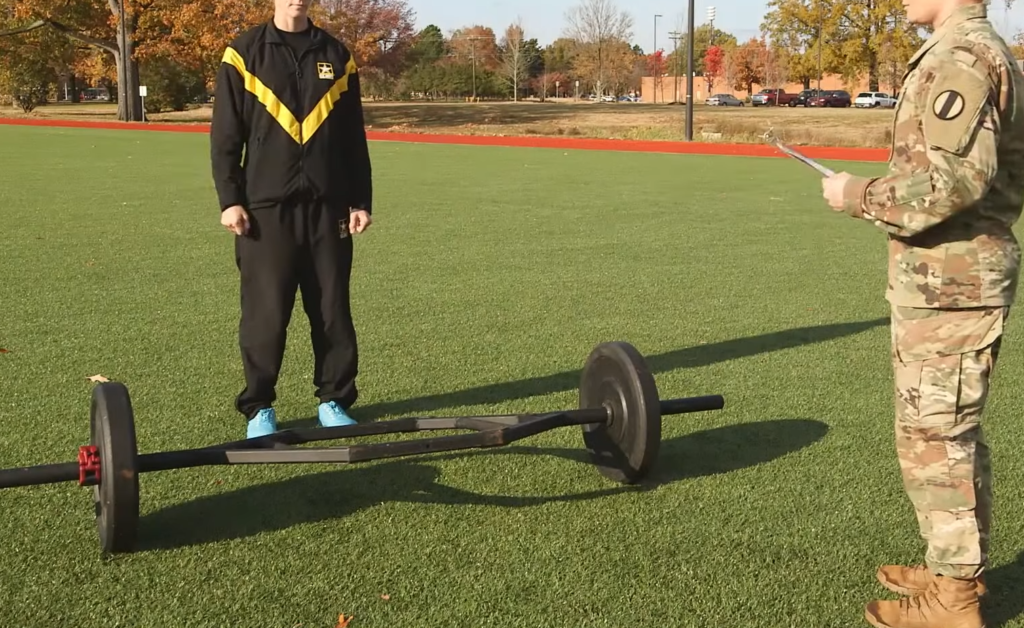
In the ACFT, the Deadlift Event replaces the traditional three-event Army Physical Fitness Test (APFT), emphasizing a more comprehensive evaluation of a soldier’s physical capabilities. The Deadlift Event specifically targets the muscle groups essential for performing various military tasks, such as carrying equipment, lifting casualties, and navigating challenging terrain.
During the Deadlift Event, soldiers are required to lift a hexagonal barbell with weights from the ground to a standing position, maintaining proper form throughout the movement. The barbell is loaded with standardized weights, and soldiers must successfully lift a predetermined amount based on their gender and age. This event assesses a soldier’s lower back, gluteal, and hamstring strength, as well as overall posture and body mechanics.
One of the key features of the Deadlift Event is its scalability, accommodating soldiers of different strength levels and body weights. The weights lifted are proportionate to the soldier’s body weight, ensuring a fair evaluation across the diverse demographics of the Army. This approach promotes inclusivity and encourages soldiers to focus on improving their individual fitness levels, regardless of their starting point [2].
The Deadlift Event not only measures raw strength but also emphasizes the importance of proper technique and form. Soldiers must lift the barbell using a “hex” grip, with their hands positioned on the bar’s six sides. This grip simulates real-world lifting scenarios and enhances the transferability of strength to practical military tasks.
Integrating the Deadlift Event into the ACFT aligns with the Army’s commitment to enhancing soldier readiness for the physical demands of contemporary warfare. By placing a premium on functional strength and proper body mechanics, the ACFT Deadlift Event contributes to a more holistic approach to assessing and improving the overall fitness of the Army’s personnel.
What Is Hex Bar Maximum Deadlift (MDL)?
[tds_note]The Hex Bar Maximum Deadlift (MDL) is a specific variation of the deadlift exercise performed using a hexagonal barbell, also known as a trap bar. This variation differs from the traditional barbell deadlift in terms of equipment and body mechanics, offering some unique advantages [3].[/tds_note]
The hex bar, as the name suggests, has a hexagonal shape with handles on either side. This design allows the lifter to stand inside the bar rather than behind it, with the weight evenly distributed on either side of the body. The Hex Bar MDL involves lifting the loaded hex barbell from the ground to a standing position, similar to the conventional deadlift.
The Hex Bar MDL is a popular exercise in strength training and is often used in various fitness settings, including sports performance training, general fitness programs, and military fitness assessments like the Army Combat Fitness Test (ACFT).
Here are some key aspects of the Hex Bar MDL:
- Mechanics and Form: The hexagonal design of the bar allows for a more natural and upright posture during the lift. This can reduce stress on the lower back compared to the traditional deadlift, making it a preferred option for individuals with lower back concerns;
- Muscles Targeted: Like the conventional deadlift, the Hex Bar MDL primarily targets the posterior chain muscles, including the hamstrings, glutes, and lower back. Additionally, it engages the quadriceps, upper back, and grip strength;
- Versatility: The Hex Bar MDL is versatile and can be adapted to different fitness levels. The lift’s intensity can be adjusted by varying the amount of weight loaded onto the bar, making it suitable for both beginners and advanced lifters;
- Safety: The hexagonal design of the bar allows the lifter to maintain a more neutral spine position, potentially reducing the risk of lower back injuries. Additionally, the elevated handles provide an ergonomic grip that is gentler on the wrists;
- Application in Fitness Assessments: In the context of military fitness assessments, such as the ACFT, the Hex Bar MDL may be used as one of the events to evaluate a soldier’s strength and functional fitness. The weight lifted is standardized based on the individual’s body weight and gender;
The Hex Bar MDL is a valuable addition to strength training routines, offering a safe and effective way to develop overall strength and power. Whether used in military training or general fitness programs, incorporating this exercise can contribute to improved functional fitness and reduced risk of injury.
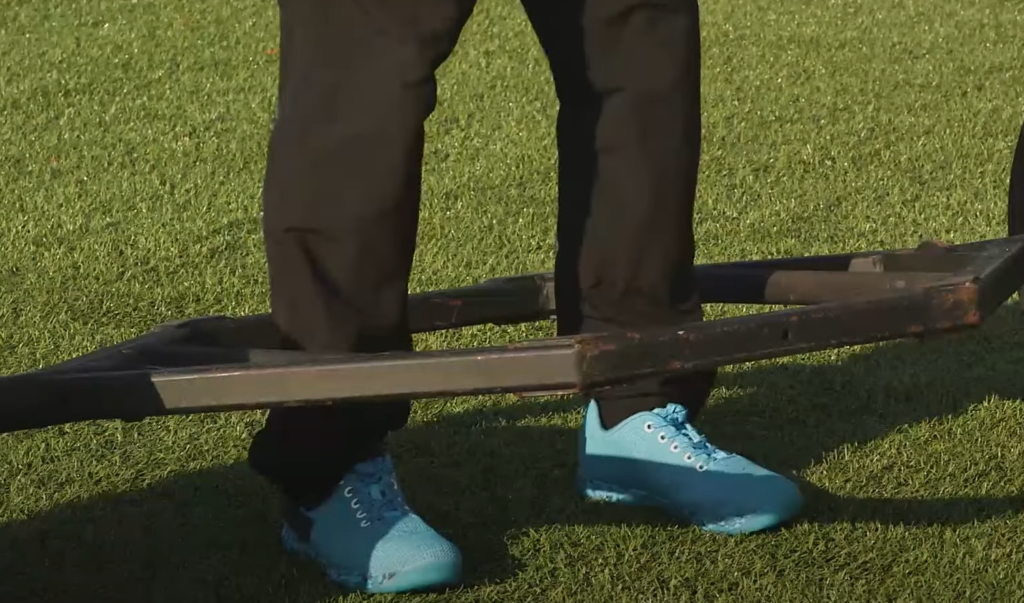
The U.S. Army Deadlift Requirements
The U.S. Army deadlift requirements are part of the Army Combat Fitness Test (ACFT). This test replaced the older Army Physical Fitness Test (APFT) in 2020 and assesses a Soldier’s overall fitness for combat tasks [4].
Here’s a breakdown of the deadlift requirements in the ACFT:
- Event: Maximum Deadlift (MDL);
- Type: Three-repetition maximum;
- Weight range: 120 to 420 pounds;
Scoring
Points are awarded based on the total weight lifted across the three repetitions.
Minimum score to pass: There is no minimum score required to pass the ACFT itself. However, Soldiers need to achieve a minimum score in each event, including the deadlift, to qualify for certain promotions, assignments, and deployments.
Scoring standards:
- The age group of 17-21 for males – the minimum weight is 140 lbs and maximum weight is 340 lbs, with 60 and 100 points respectively;
- The age group of 17-21 for females – the minimum weight is 140 lbs and maximum weight is 340 lbs, with 40 and 80 points respectively;
- The age group of 22-26 for males – the minimum weight is 140 lbs and maximum weight is 340 lbs, with 55 and 95 points respectively;
- The age group of 22-26 for males – the minimum weight is 140 lbs and maximum weight is 340 lbs, with 35 and 75 points respectively [5];
Additional notes:
- The deadlift is performed using a hexagonal bar with weight plates;
- Soldiers have three attempts to lift their maximum weight for each repetition;
- Proper form is crucial for safety and scoring;
- Soldiers are encouraged to train regularly to improve their deadlift performance;
ACFT Deadlift Scoring Standards In 2024:
For Men
The scoring for men typically starts at 140 pounds and increases incrementally. The score categories could range from 60 points, which is the minimum to pass, to 100 points, which indicates maximum performance. The exact weight required for each score can vary, so specific numbers would be needed to give an accurate table of standards [6].
For Women
For women, the scoring also begins at a lower weight than for their male counterparts and increases in increments. As with the men’s scoring, the range goes from 60 points up to 100 points, with increasing weights corresponding to higher scores.
Deadlift Standards In 2024:
Purpose:
The purpose of establishing Deadlift Standards in 2023 is to ensure a standardized and effective means of assessing an individual’s strength and functional fitness. As the fitness landscape evolves, so too must the benchmarks that guide training programs and performance evaluations. The Deadlift, a fundamental compound exercise, has been a staple in strength assessments, and updating the standards ensures relevance to contemporary fitness needs.
Equipment:
The equipment utilized in Deadlift Standards remains a critical aspect of the assessment. In 2023, the focus is on incorporating modern variations such as the Hex Bar, which provides additional benefits in terms of reduced lower back stress and improved posture during the lift. The use of a standardized hexagonal barbell ensures consistency across assessments, allowing for fair comparisons among individuals of varying fitness levels.
Pre-Test:
Before engaging in the Deadlift Standards assessment, participants should undergo a thorough pre-test evaluation. This includes a health screening to identify any pre-existing conditions or injuries that may impact the individual’s ability to perform the exercise safely.
Additionally, a basic fitness assessment may be conducted to gauge overall mobility, flexibility, and strength levels. This pre-test phase ensures that participants are physically prepared for the Deadlift Standards and helps identify any specific considerations or modifications required for individual cases.
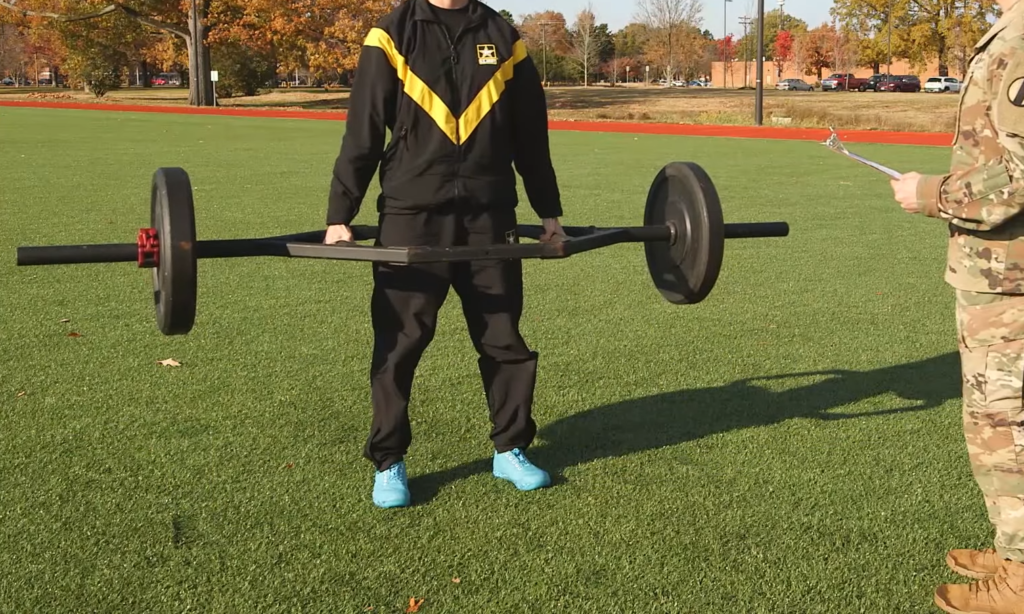
Procedure:
The Deadlift Standards procedure in 2024 is a systematic and carefully designed process aimed at evaluating an individual’s strength in a controlled and standardized manner [7].
This section outlines the step-by-step procedure for conducting the Deadlift Standards assessment:
Step 1: Warm-up
Before initiating the Deadlift Standards assessment, participants should undergo a comprehensive warm-up routine. This may include dynamic stretches, light cardiovascular activity, and specific warm-up sets with lighter weights to prepare the muscles and joints for the upcoming exertion.
Step 2: Explanation and Demonstration
A certified fitness professional or instructor should provide a detailed explanation of the Deadlift Standards assessment. This includes demonstrating proper form, grip placement, and body mechanics. Participants should have a clear understanding of the lift’s requirements and the importance of maintaining correct technique throughout the assessment.
Step 3: Equipment Setup
Ensure that the hexagonal barbell is set up with the appropriate weights based on the participant’s body weight and gender. The barbell should be placed on a level surface, and the participant should stand inside the hex bar with the handles aligned parallel to their body.
Step 4: Participant Positioning
Participants should stand with their feet hip-width apart inside the hex bar, ensuring that their mid-foot is positioned under the barbell. The grip on the handles should be symmetrical, with the lifter’s arms hanging straight down, creating a “hex” grip. This positioning allows for a neutral spine and engages the posterior chain effectively.
Step 5: Lifting Procedure
On the instructor’s signal, participants will initiate the lift by pushing through their heels, extending their hips and knees simultaneously. It’s crucial to emphasize the controlled nature of the lift, avoiding jerky movements or rounding of the back. The participant should stand fully upright with the shoulders pulled back at the top of the lift.
Step 6: Lowering the Barbell
After reaching the fully upright position, participants should lower the hex barbell back to the ground in a controlled manner. The movement should mirror the upward phase, maintaining proper form and posture throughout. The barbell should touch the ground between each repetition to complete the full range of motion.
Step 7: Repetitions and Completion
Participants will perform the Deadlift Standards for a specified number of repetitions or until failure, depending on the assessment criteria. The number of repetitions and the weight lifted are standardized based on the participant’s body weight and gender, allowing for a fair comparison of strength levels across diverse demographics [8].
Step 8: Cool Down
Following the Deadlift Standards assessment, participants should engage in a cooldown routine to promote recovery and flexibility. This may include static stretches, light aerobic activity, and hydration to support the body’s recovery process.
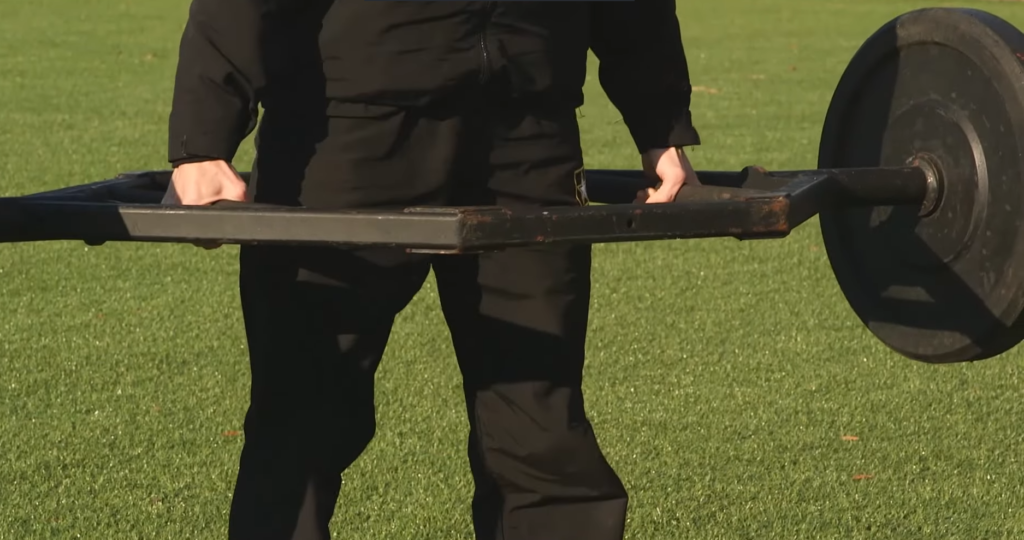
Workouts To Improve Deadlift Routine:
A robust deadlift is often considered a hallmark of overall strength and functional fitness. To amplify your deadlift routine and break through plateaus, incorporating targeted exercises can make a significant difference.
Here are three workouts that can help improve your deadlift routine:
1. Deficit Romanian Deadlifts
Purpose:
Deficit Romanian Deadlifts focus on increasing the range of motion in the hip hinge pattern, emphasizing the posterior chain, including the hamstrings and glutes. The deficit created by standing on an elevated surface enhances the stretch on these muscles, contributing to improved flexibility and strength.
Execution:
- Setup: Stand on a platform or blocks, elevating your feet slightly;
- Grip: Hold a barbell with a hip-width overhand grip, allowing your arms to hang directly beneath your shoulders;
- Movement: Hinge at the hips while keeping your back flat, and lower the barbell towards the ground.
- Stretch: Feel the deep stretch in your hamstrings, maintaining a neutral spine;
- Pull: Engage your glutes and hamstrings to return to the upright position, focusing on the hip hinge movement;
Benefits:
- Increased Range of Motion: The deficit challenges your muscles through a longer range of motion, promoting flexibility;
- Targeted Muscle Engagement: Emphasizes the posterior chain, crucial for deadlift performance;
- Improved Hip Hinge: Enhances the hip hinge pattern, translating to better deadlift mechanics;
2. Heavy Barbell Rows
Purpose:
Heavy Barbell Rows are an effective compound movement that targets the upper back, lats, and grip strength. Strengthening these muscle groups contributes to a more stable and powerful deadlift.
Execution:
- Setup: Stand with your feet hip-width apart, holding a barbell with an overhand grip;
- Position: Hinge at the hips, maintaining a flat back, and let the barbell hang directly beneath your shoulders;
- Pull: Row the barbell towards your lower chest, keeping your elbows close to your body;
- Squeeze: Contract your back muscles at the top of the movement, emphasizing the squeeze;
Benefits:
- Upper Back Strength: Targets the muscles involved in scapular retraction, crucial for deadlift stability;
- Improved Grip: Enhances grip strength, a vital component in maintaining control during heavy deadlifts;
- Lat Engagement: Reinforces lat muscle activation, aiding in the initiation of the deadlift pull;
3. Trap Bar Deadlift Progression
Purpose:
The Trap Bar Deadlift offers a unique approach to deadlift training by altering the biomechanics of the movement. This variation can be particularly beneficial for individuals looking to reduce lower back stress while still developing overall lower body strength.
Execution:
- Setup: Stand inside the trap bar with your feet hip-width apart;
- Grip: Grasp the handles with a neutral grip, ensuring your palms face each other;
- Position: Hinge at the hips, maintaining a neutral spine, and grip the handles;
- Lift: Drive through your heels, extending your hips and knees simultaneously to lift the trap bar;
- Controlled Descent: Lower the trap bar back to the ground with control, repeating the movement;
Benefits:
- Neutral Spine: Easier on the lower back due to the neutral grip and altered body positioning;
- Quadriceps and Glute Engagement: Targets the quadriceps and glutes effectively, promoting overall lower body strength;
- Improved Mechanics: Provides a different deadlift variation, aiding in muscle balance and reducing monotony;
Incorporating these workouts into your training routine can enhance your deadlift performance by addressing specific muscle groups, improving range of motion, and diversifying your training approach. Remember to prioritize proper form and gradually progress the intensity to avoid overexertion and injury. As with any fitness program, consult with a fitness professional or healthcare provider to ensure these exercises align with your individual needs and goals [9].

Deadlift Tips And Techniques For Beginners
[tds_note]Deadlifts are a fundamental compound exercise that engages multiple muscle groups and plays a pivotal role in building overall strength. For beginners, mastering proper deadlift form is essential to ensure both effectiveness and safety.[/tds_note]
Here are some tips and techniques to help beginners approach deadlifts with confidence:
1. Start with Proper Warm-Up:
Before attempting deadlifts, engage in a comprehensive warm-up. This should include light aerobic exercise, dynamic stretches, and specific warm-up sets with lighter weights. Warming up increases blood flow to the muscles, improves flexibility, and prepares your body for the demands of the deadlift.
2. Perfect Your Setup:
A solid setup is the foundation of a successful deadlift. Follow these steps for an effective starting position:
- Stand with your feet hip-width apart;
- Position your toes under the barbell;
- Keep your shins close to the bar;
- Grip the bar with your hands slightly wider than shoulder-width apart;
3. Maintain a Neutral Spine:
One of the most critical aspects of deadlifting is maintaining a neutral spine throughout the movement. Avoid rounding or arching your back, as this can lead to injuries. Keep your back straight, chest up, and shoulder blades back and down.
4. Hinge at the Hips:
Initiate the movement by hinging at your hips. Push your hips back as if closing a car door with your rear, allowing your torso to lean forward. This hip hinge motion is crucial for engaging the posterior chain and protecting your lower back.
5. Grip the Bar Properly:
Choose a grip that suits your comfort and goals. The double overhand grip (both palms facing you) is standard for beginners. Ensure a firm grip without over-gripping to avoid unnecessary fatigue in your forearms.
6. Engage Your Lats:
Before lifting the bar, engage your lats by imagining tucking your shoulder blades into your back pockets. This creates tension in your upper back, stabilizing your spine and providing a solid foundation for the lift.
7. Drive Through Your Heels:
As you lift the bar, focus on pushing through your heels. This engages your hamstrings and glutes, providing power for the upward movement. Avoid lifting onto your toes, as this can compromise balance and form.
8. Stand Tall at the Top:
At the top of the lift, stand fully upright, extending your hips and knees. Finish with your shoulders back, creating a straight line from head to heels. Avoid hyperextending your lower back.
9. Controlled Descent:
Lower the bar back to the ground with control. Maintain the hip hinge motion and ensure a smooth descent. Avoid letting the bar crash down, as this can strain your lower back.

10. Practice with Light Weights Initially:
Start with a weight that allows you to focus on proper form. Gradually increase the weight as you become more comfortable with the movement. Avoid the temptation to lift heavy weights without mastering the fundamentals.
11. Use a Mirror or Trainer:
If possible, perform deadlifts in front of a mirror or seek guidance from a certified trainer. This allows you to visually check your form and receive immediate feedback.
12. Listen to Your Body:
Pay attention to how your body feels during and after deadlifts. If you experience pain beyond normal muscle fatigue, reassess your form and consider consulting with a fitness professional or healthcare provider.
Trouble Spots On the Deadlift Routine
The deadlift is a compound exercise that engages multiple muscle groups, making it highly effective for building strength and muscle mass. However, like any complex movement, the deadlift can present challenges, and identifying trouble spots in your routine is crucial for improvement and injury prevention.
Here are common trouble spots in the deadlift routine and tips to address them:
1. Setup and Stance:
Issue: Incorrect setup can compromise your entire deadlift. Problems may arise from a wide or narrow stance, misalignment with the bar, or improper grip.
Solution:
- Ensure a hip-width stance with toes pointing forward;
- Align your mid-foot under the barbell;
- Use a grip slightly wider than shoulder-width for a balanced and comfortable setup;
2. Back Position:
Issue: Rounding or arching of the back during the lift can lead to spinal injuries.
Solution:
- Maintain a neutral spine from the start to the finish of the lift;
- Keep your chest up and shoulder blades back to avoid rounding;
- Engage your core to support your spine throughout the movement;
3. Hip Hinge:
Issue: Insufficient hip hinge can limit engagement of the posterior chain and increase stress on the lower back.
Solution:
- Initiate the movement by pushing your hips back, not by bending your knees;
- Feel the stretch in your hamstrings and engage your glutes as you hinge;
4. Bar Path:
Issue: The barbell drifting away from your body can create leverage issues and compromise form.
Solution:
- Keep the bar close to your body throughout the lift;
- Think about dragging the bar up your shins and thighs;
5. Knee Position:
Issue: Allowing the knees to collapse inward or pushing them too far forward can impact stability and force distribution.
Solution:
- Keep your knees in line with your toes throughout the lift;
- Ensure they don’t cave inward, maintaining a stable knee position;
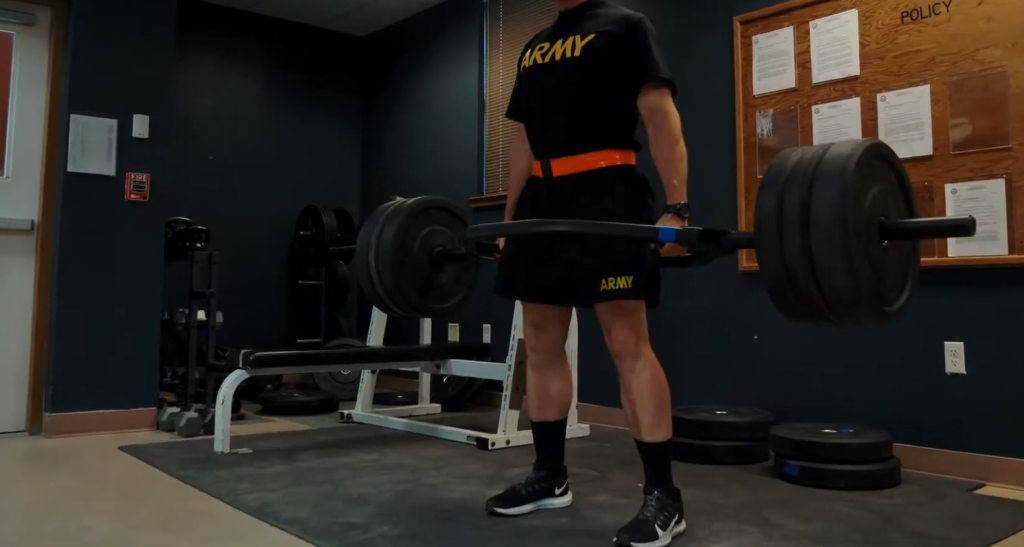
6. Grip Strength:
Issue: Weak grip strength can lead to an early release of the barbell, limiting the lift.
Solution:
- Strengthen your grip with accessory exercises like farmer’s walks or grip-specific training;
- Consider using mixed grip or hook grip for added grip security;
7. Lockout:
Issue: Failing to fully lock out at the top of the lift can limit muscle engagement and strength gains.
Solution:
- Stand tall at the end of the lift with your hips fully extended;
- Squeeze your glutes and push your hips forward to ensure a complete lockout;
8. Overreliance on Lower Back:
Issue: Relying too much on the lower back and neglecting the engagement of the hamstrings and glutes.
Solution:
- Focus on pushing through your heels to engage the hamstrings and glutes;
- Use the entire posterior chain to share the load evenly;
9. Breathing and Core Activation:
Issue: Inadequate breath control and core activation can compromise stability and spinal support.
Solution:
- Take a deep breath before initiating the lift and brace your core;
- Maintain this abdominal tension throughout the entire movement;
10. Programming and Progression:
Issue: Poor programming or progressing too quickly can lead to burnout or increased risk of injury.
Solution:
- Incorporate progressive overload gradually, ensuring your body adapts to increased demands;
- Include sufficient rest and recovery in your training plan;
11. Mobility Issues:
Issue: Lack of mobility in the hips, hamstrings, or ankles can hinder your deadlift performance.
Solution:
- Include dynamic stretching and mobility exercises in your warm-up routine;
- Address specific mobility limitations through targeted stretches and exercises;
[tds_council]Addressing these trouble spots in your deadlift routine requires a combination of mindful practice, targeted exercises, and a focus on overall form. Consider seeking guidance from a qualified fitness professional to receive personalized feedback and ensure a safe and effective deadlift routine. Consistent attention to these areas will contribute to improved performance and reduced risk of injury over time.[/tds_council]
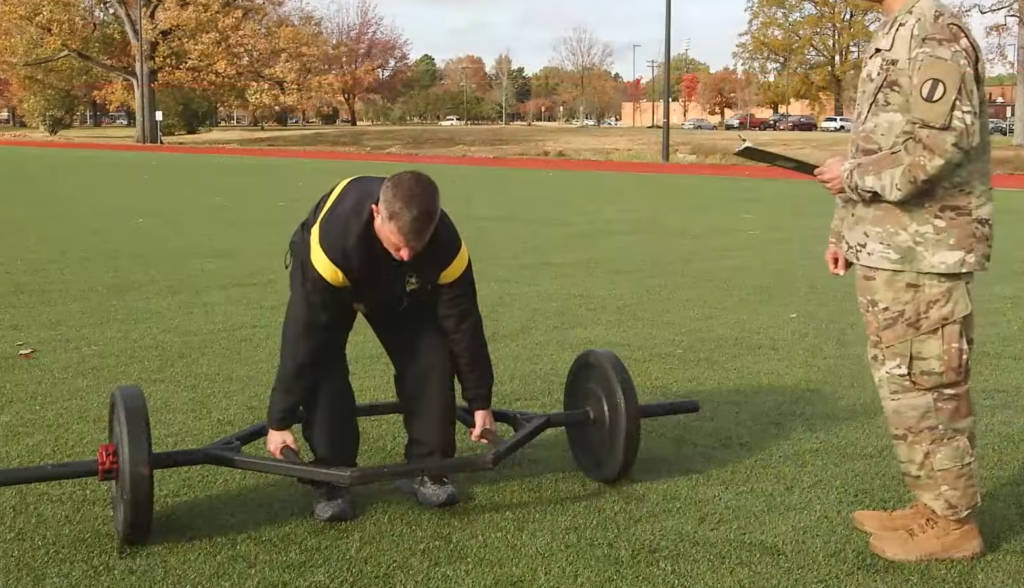
FAQ:
1. What is the standard deadlift for the ACFT?
The standard deadlift for the Army Combat Fitness Test (ACFT) involves using a hexagonal barbell, commonly known as a hex bar, to lift weights from the ground to a standing position.
2. What is the new ACFT score in 2024?
As of 2024, the specific ACFT scoring system may vary. It is recommended to refer to the most recent Army regulations or official sources for the latest information on ACFT scoring.
3. What is the Black standard for the ACFT deadlift events?
The Black standard in ACFT deadlift events refers to a performance level that exceeds the minimum requirements, indicating a high level of strength and fitness.
4. How much does the ACFT deadlift bar weigh?
The ACFT deadlift bar weighs 25 kilograms (approximately 55 pounds) for both male and female participants.
5. How do you set up deadlifts for ACFT?
To set up deadlifts for ACFT, stand inside the hex bar with feet hip-width apart, ensuring proper grip and alignment. The barbell should be loaded based on standardized weights corresponding to your body weight and gender.
6. How many people fail the ACFT?
The pass or fail rate on the ACFT can vary. It depends on individual performance and the specific standards set for each event. Training and preparation are key factors in achieving successful results.
7. Is hex bar deadlift easier?
Many individuals find the hex bar deadlift to be more user-friendly as it typically places less stress on the lower back and provides a more natural lifting position compared to the traditional barbell deadlift.
8. What are the ACFT heavy standards?
The heavy standards in ACFT refer to achieving a higher performance level, indicating superior strength and fitness. These standards may vary based on individual factors such as age, gender, and job requirements.
9. What is an acceptable deadlift?
An acceptable deadlift in the ACFT is one that meets or exceeds the minimum standards set for the event, demonstrating sufficient strength and technique.
10. Is a hex bar safer than a deadlift?
The hex bar deadlift is often considered safer for the lower back due to its design, which allows for a more upright posture during the lift. However, individual preferences and biomechanics may vary.
11. What is the 540 rule in the Army?
The 540 rule in the Army refers to the requirement that soldiers must score at least 60 points in each of the six ACFT events, totaling a minimum of 360 points to pass the test.
12. Can you do height and weight before ACFT?
Yes, height and weight standards are typically assessed as part of a soldier’s overall physical readiness, including preparation for the ACFT.
13. What is the ACFT 3-rep deadlift?
The ACFT 3-rep deadlift involves lifting the hex barbell for three repetitions, with the weight determined based on the participant’s body weight and gender.
14. How heavy is the 2-plate deadlift?
The weight of a 2-plate deadlift refers to lifting a barbell with two standard 45-pound plates on each side, totaling 225 pounds (or 102 kilograms).
15. Can you wear gloves during ACFT?
Yes, soldiers are allowed to wear gloves during the ACFT to provide additional grip support and protection for the hands.
Useful Video: ACFT Deadlift Technique Tricks
References:
- https://sfnationalguard.com/6-workouts-to-max-the-army-acft/
- https://hashimashi.com/acft-deadlift-standards/
- https://usarmybasic.com/army-combat-fitness-test/
- https://www.army-fitness.com/acft-events-parent/maximum-weight-deadlift/
- https://www.armytimes.com/news/your-army/2022/01/14/we-have-a-new-approach-to-the-army-combat-fitness-test-grading-scale/
- https://www.army-fitness.com/acrt-dead-lift-standards/
- https://www.reddit.com/r/army/comments/osl6yn/what_is_a_good_weight_for_acft_deadlifts_if_i/
- https://rallyfitness.com/blogs/news/update-army-adjusting-the-acft
- https://mwi.westpoint.edu/armys-new-physical-fitness-test-one-really-big-problem-heres-solution/






Leave a Reply